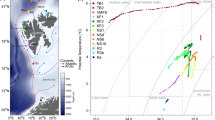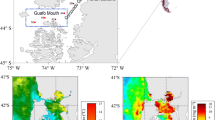Abstract
We describe selected aspects of the ecology of the copepod Eurytemora affinis in tide pools of an inland salt marsh near L'Isle-Verte, Québec along the southern shore of the St. Lawrence estuary. E. affinis performed daily horizontal migrations moving from the centers of pools to the banks and into dense algae. Male E. affinis were mainly found in the center of the pools during twilight (21 : 00 hrs) and in dense algae in daylight (12: 00 hrs) whereas most females and copepodites were found near the banks at all three sampling periods. Although these daily movements among sites may have minimized predation by diurnally foraging sticklebacks (Pisces: Gasterosteidae), other explanations for the movements can not be excluded. We also quantified the effects of fish predation upon the population structure of E. affinis. Densities of all stages (nauplius, copepodite, adult) were significantly lower in pools with fish than in pools without fish. Female E. affinis were significantly smaller (mean length) in pools with fish than in pools without fish, indicating that the sticklebacks selectively ate larger females. Male-biased sex ratios were found in both types of pools, which excluded the possibility that biased ratios in this species are caused by selective predation upon the females.
Similar content being viewed by others
References
Bousfield, E. L., G. Filteau, M. O'Neil & P. Gentes, 1975. Population dynamics of zooplankton in the middle St. Lawrence estuary. In Cronin, L. E. (ed.) Estuarine Research, 1: 325‱351. Academic Press, New York.
Bradley, B. P., 1978. Increase in temperature tolerances by acclimation in the copepod Eurytemora affinis. Biol. Bull. 154: 177–187.
Brooks, J. L. & S. I. Dodson, 1965. Predation, body size, and composition of the plankton. Science 150: 28–35.
Burkill, P. H. & T. F. Kendall, 1982. Production of the Copepod Eurytemora affinis in the Bristol Channel. Mar. Ecol. Prog. Ser. 7: 21–31.
Castonguay, M., 1988. Le rôle de la prédation dans la structuration de la population d'Eurytemora affinis (Copepoda) d'un marais salé. MSc. thesis, Université Laval, Québec, Canada. 45 pp.
Côté, R., 1972. Influence d'un mélange intensif de différents types d'eau sur la distribution spatiale et temporelle du zooplancton de l'estuaire du Saint-Laurent. MSc. thesis, Université Laval, Québec, Canada. 249 pp.
Davis, R. M., 1986. Responses of the copepod Eurytemora affinis to three environmental stressors. Ph.D. thesis, University of Maryland, Baltimore County, USA. 136 pp.
FitzGerald, G. J., 1983. The reproductive ecology and behaviour of three sympatric sticklebacks (Gasterosteidae) in a saltmarsh. Biol. of Behav. 8: 67–79.
Gauthier, B. & M. Goudreau, 1983. Maresglacielles et non glacielles dans le marais salé de L'Isle-Verte, estuaire du Saint-Laurent, Québec. Geogr. phys. Quat. 37: 49–66.
Gill, G. L., 1978. Design and analysis of experiments in the animal and medical sciences v. 2. Iowa State University Press, Ames, Iowa.
Hall, D. J., W. E. Cooper & E. E. Werner, 1970. An experimental approach to the production dynamics and structure of freshwater animal communities. Limnol. Oceanogr. 15: 839–928.
Heinle, D. R., 1969. Temperature and zooplankton. Chesapeake Sci. 10: 186–209.
Heinle, D. R. & D. A. Flemer, 1975. Carbon requirements of a population of the estuarine copepod Eurytemora affinis. Mar. Biol. 31: 235–247.
Heinle, D. R., R. P. Harris, J. F. Ustach & D. A. Flemer, 1977. Detritus as food for estuarine copepods. Mar. Biol. 40: 341–353.
Hulbert, S. M. & M. S. Mulla, 1981. Impact of mosquitofish (Gambusia affinis) predation on plankton communities. Hydrobiologia 83: 125–151.
Jeffries, H. P., 1962. Salinity-space distribution of the estuarine copepod genus Eurytemora. Int. revue. ges. Hydrobiol. Hydrogr. 47: 291–300.
Katona, S. K., 1970. Growth characteristics of the copepods Eurytemora affinis and E. herdmani in laboratory cultures. Helgolander wiss. Meeresunters. 20: 373–384.
Katona, S. K., 1971. The developmental stages of Eurytemora affinis (Poppe, 1880) (Copepoda, Calanoida) raised in laboratory cultures, including a comparison with the larvae of Eurytemora americana Williams, 1906, and E. herdmani Thompson and Scott, 1897. Crustaceana 21: 5–21.
Kirk, R. E., 1982. Experimental design: procedures for the behavioral sciences. Brooks/Cole Publishing Co., Belmont, Ca.
Klemetsen, A., 1970. Plankton swarms in lake Gjokvatn, East Finmark, Astarte. J. arct. Biol. 3: 83–85.
Lynch, M., 1979. Predation, competition, and zooplankton community structure: an experimental study. Limnol. Oceanogr. 24: 253–272.
McCauley, E., 1984. The estimation of the abundance and biomass of zooplankton in samples. In Downing, J. A., & F. A. Rigler (eds). A manual for the assessment of secondary productivity in freshwater. 2nd edition, Blackwell Scientific Publications, Oxford, England.
McQuinn, I., G. J. FitzGerald & H. Powles, 1983. Environmental effects on embryonic and larval survival of the Isle Verte stock of Atlantic herring. Nat. can. 110: 343–353.
Ohman, M. D., 1986. Predator-limited population growth of the copepod Pseudocalanus sp. J. Plankton Res. 8: 673–713.
Poppe, S. A., 1880. Über eine neue Art der Calaniden-Gattung Temora. Baird. Abh. naturw. Ver. Bremen, 7: 55–60.
Reed, A. & G. Moisan, 1971. The Spartina tidal marshes of the St. Lawrence estuary and their importance to aquatic birds. Nat. Can (Que.) 98: 905–927.
Sandström, O., 1980. Selective feeding by the Baltic herring. Hydrobiologia 69: 199–207.
Snee, R. D., 1974. Graphical display of two-way contingency tables. American Statistician 28: 9–12.
Vanni, M. J., 1986. Fish predation and zooplankton demography: indirect effects. Ecology 67: 337–354.
Vanni, M. J., 1987. Effects of food availability and fish predation on a zooplankton community. Ecol. Mongr. 57: 61–88.
Visser, M., 1982. Prey selection by the three-spined stickleback (Gasterosteus aculeatus L.). Oecologia 55: 395–402.
Vuorinen, I., M. Rajasilta & J. Salo, 1983. Selective predation and habitat shift in a copepod species-support for the predation hypothesis. Oecologia 59: 62–64.
Walsh, G. & G. J. FitzGerald, 1984. Resource utilization and coexistence of three species of sticklebacks (Gasterosteidae) in tidal salt-marsh pools. J. Fish Biol. 25: 405–420.
Ward, G. & G. J. FitzGerald, 1983a. Macrobenthic abundance and distribution in tidal pools of a Quebec salt marsh. Can. J. Zool. 61: 1071–1085.
Ward, G. & G. J. FitzGerald, 1983b. Fish predation on the macrobenthos of tidal salt marsh pools. Can. J. Zool. 61: 1358–1361.
Ward, H. B., 1959. Freshwater biology. John Wiley & Sons, New York.
Wetzel, R. G., 1983. Limnology. Saunders College Publishing, New York.
Wootton, R. J., 1976. The Biology of the Sticklebacks. Academic Press, London.
Worgan, J. P. & G. J. FitzGerald, 1981a. Diel activity and diet of three sympatric sticklebacks in tidal salt marsh pools. Can. J. Zool. 59: 2375–2379.
Worgan, J. P. & G. J. FitzGerald, 1981b. Habitat segregation in a salt marsh among adult sticklebacks (Gasterosteidae). Envir. Biol. Fishes 6: 105–109.
Zaret, T. M., 1980. Predation and freshwater communities. Yale University Press, New Haven.
Author information
Authors and Affiliations
Rights and permissions
About this article
Cite this article
Castonguay, M., FitzGerald, G.J. The ecology of the calanoid copepod Eurytemora affinis in salt marsh tide pools. Hydrobiologia 202, 125–133 (1990). https://doi.org/10.1007/BF00006839
Revised:
Accepted:
Issue Date:
DOI: https://doi.org/10.1007/BF00006839




